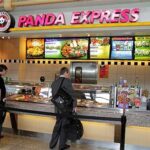
Panda Express, the ubiquitous American Chinese fast-food chain, faces an uphill battle to revitalize its image and win back consumers who crave authentic flavors and higher-quality ingredients amidst growing competition and evolving palates.
Panda Express, a fast-food giant synonymous with American Chinese cuisine, is grappling with an identity crisis. The chain, known for its orange chicken and convenient accessibility, faces increasing scrutiny as consumers demand more authentic flavors and fresher ingredients. The brand, despite its widespread presence, is now challenged to prove it can evolve beyond its established, sometimes criticized, menu and reclaim its position in a competitive culinary landscape.
Founded in 1983 by Andrew and Peggy Cherng, Panda Express quickly became a staple in American malls and food courts. Its success was built on offering familiar, approachable Chinese-inspired dishes tailored to the American palate. The sweet and tangy Orange Chicken became a phenomenon, contributing significantly to the chain’s popularity and ubiquity. However, this very success has also become a point of contention, as food critics and consumers alike argue that Panda Express’s menu has strayed too far from authentic Chinese cuisine, relying heavily on sugar, sodium, and processed ingredients.
The Rise and Reign of Orange Chicken
Orange Chicken, a dish featuring battered and fried chicken coated in a sweet orange-flavored sauce, is undeniably the cornerstone of Panda Express’s success. Its widespread appeal transformed Panda Express from a regional chain into a national powerhouse. However, its heavy reliance on sugar and sodium has also made it a target for those seeking healthier and more authentic dining options.
“We built our brand on Orange Chicken,” acknowledges Andrea Cherng, Chief Brand Officer and daughter of the founders, in various interviews. This statement highlights the complex relationship Panda Express has with its signature dish. While Orange Chicken remains a top seller, the company recognizes the need to diversify and offer dishes that cater to a broader range of tastes and dietary preferences.
Evolving Consumer Tastes
Consumer preferences have shifted dramatically in recent years. There’s a growing demand for authentic ethnic cuisine, with diners seeking out regional specialties and bolder flavors. This trend has fueled the rise of smaller, independent Chinese restaurants and specialized chains that focus on specific regional cuisines like Sichuan, Cantonese, and Hunan.
Panda Express’s challenge is to adapt to these evolving tastes without alienating its core customer base, who are accustomed to its familiar menu. This requires a delicate balancing act: introducing new, more authentic dishes while maintaining the accessibility and affordability that have always been hallmarks of the brand.
Ingredient Quality and Sourcing
Another key area of concern for Panda Express is the quality and sourcing of its ingredients. In an era where consumers are increasingly conscious of what they eat, the chain has faced criticism for its use of processed ingredients and reliance on large-scale suppliers.
“There’s always room for improvement when it comes to ingredient sourcing and preparation,” admits a former Panda Express employee, who spoke on condition of anonymity. This sentiment is echoed by many food bloggers and online reviewers who have criticized the chain for its perceived lack of fresh ingredients and reliance on pre-made sauces and frozen components.
Competition in the Fast-Casual Market
The fast-casual dining segment has become increasingly competitive, with a plethora of options available to consumers. From Chipotle to Panera Bread to a growing number of Asian-inspired chains, diners have more choices than ever before.
Panda Express faces the challenge of differentiating itself in this crowded marketplace. While its brand recognition and widespread presence are significant advantages, the chain must also demonstrate that it can offer a superior dining experience in terms of food quality, taste, and customer service.
Efforts to Revitalize the Brand
Panda Express is not oblivious to the challenges it faces. The company has been actively working to revitalize its brand and address consumer concerns. These efforts include:
Menu Innovation: Panda Express has been experimenting with new menu items that showcase more authentic Chinese flavors and ingredients. These include dishes inspired by regional Chinese cuisines, as well as healthier options with lower sodium and sugar content. The chain has also introduced premium ingredients like Angus beef and sustainably sourced seafood in select dishes.
Chef Collaboration: Panda Express has partnered with renowned chefs and culinary experts to develop new recipes and improve the quality of its existing menu items. This collaboration is aimed at bringing fresh perspectives and culinary expertise to the chain’s food development process.
Restaurant Design and Ambiance: Panda Express has been updating its restaurant design to create a more modern and inviting atmosphere. The new restaurant design features brighter lighting, more comfortable seating, and open kitchens that allow customers to see their food being prepared.
Technology Integration: Panda Express has been investing in technology to improve the customer experience. This includes online ordering, mobile apps, and self-service kiosks that allow customers to place orders and customize their meals. The chain is also exploring the use of artificial intelligence to personalize recommendations and optimize the ordering process.
Transparency and Sustainability: Panda Express is making efforts to be more transparent about its ingredient sourcing and food preparation practices. The company has launched initiatives to promote sustainable sourcing and reduce its environmental impact.
The Future of Panda Express
The future of Panda Express hinges on its ability to successfully navigate the challenges it faces. The chain must balance its commitment to its core customer base with the need to adapt to evolving consumer tastes and preferences. It must also improve the quality and sourcing of its ingredients while maintaining its affordability and accessibility.
“We are committed to providing our guests with a great dining experience,” says Andrea Cherng. “We are constantly working to improve our food, our service, and our restaurants.”
Whether these efforts will be enough to restore Panda Express’s reputation as a purveyor of quality Chinese-inspired cuisine remains to be seen. However, the chain’s willingness to adapt and innovate suggests that it is serious about addressing the challenges it faces and reclaiming its position in the competitive fast-casual market. The path forward requires Panda Express to acknowledge its past, embrace innovation, and prioritize quality and authenticity in its food offerings.
Challenges and Criticisms
Despite its efforts, Panda Express continues to face criticism. Some food critics argue that the chain’s menu is still too heavily reliant on sugar, sodium, and processed ingredients. Others question the authenticity of its dishes, arguing that they are merely Americanized versions of Chinese cuisine.
One of the main criticisms leveled against Panda Express is its reliance on pre-made sauces and frozen ingredients. This practice, while efficient and cost-effective, is seen as compromising the quality and freshness of the food.
Another challenge for Panda Express is maintaining consistency across its vast network of restaurants. With thousands of locations around the world, it can be difficult to ensure that every restaurant adheres to the same standards of quality and service.
Employee Treatment
In addition to the food-related criticisms, Panda Express has also faced scrutiny regarding its treatment of employees. Some former employees have alleged that the chain has a demanding work environment and that it does not always provide adequate training and support. While Panda Restaurant Group has stated it values its employees and provides competitive benefits, these claims still damage the image of the company.
Panda Express’s ongoing success depends on its ability to address these criticisms and improve its overall operations. The chain must demonstrate that it is committed to providing its employees with a positive work environment and that it is dedicated to serving high-quality, authentic food.
Panda Express’s Response
Panda Express is actively addressing these criticisms. The chain is investing in employee training programs to improve customer service and ensure consistency across all locations. Additionally, Panda Express is working with suppliers to source higher-quality ingredients and reduce its reliance on processed foods.
The Future Menu
The chain’s future menu is expected to feature more dishes that showcase regional Chinese cuisines. Panda Express is also exploring the use of innovative cooking techniques to enhance the flavor and texture of its food. One example is the introduction of wok-fired dishes, which are cooked at high temperatures to create a smoky, charred flavor.
Panda Express is also considering offering more customizable options, allowing customers to tailor their meals to their specific dietary needs and preferences. This could include offering gluten-free, vegetarian, and vegan options.
“We are committed to providing our guests with a wide range of delicious and authentic Chinese-inspired dishes,” says Andrea Cherng. “We are constantly experimenting with new flavors and ingredients to create exciting and innovative menu items.”
The success of Panda Express’s revitalization efforts will depend on its ability to win back consumers who have been turned off by its perceived lack of authenticity and quality. The chain must demonstrate that it is willing to evolve and adapt to meet the changing demands of the marketplace.
Marketing Strategies
Panda Express has increased its marketing efforts to highlight its new menu items and its commitment to quality and authenticity. The chain has launched a series of television commercials and online videos that showcase its chefs and its ingredient sourcing practices.
Panda Express is also using social media to engage with its customers and gather feedback on its menu and service. The chain has created a Facebook page, a Twitter account, and an Instagram profile where it shares updates, promotions, and behind-the-scenes content.
Community Involvement
Panda Express is actively involved in the communities where it operates. The chain supports a variety of charitable organizations and community events. Panda Express also has a scholarship program that provides financial assistance to students who are pursuing higher education.
“We believe that it is important to give back to the communities that support us,” says Andrea Cherng. “We are committed to being a good corporate citizen and making a positive impact on the world.”
Long-Term Outlook
The long-term outlook for Panda Express is uncertain. The chain faces significant challenges in the form of increased competition, evolving consumer tastes, and ongoing criticisms of its food quality and employee treatment.
However, Panda Express also has several advantages that could help it overcome these challenges. The chain has strong brand recognition, a vast network of restaurants, and a dedicated team of employees. Panda Express is also investing in menu innovation, technology integration, and community involvement.
Ultimately, the success of Panda Express will depend on its ability to adapt and evolve. The chain must demonstrate that it is willing to listen to its customers, address their concerns, and provide them with a high-quality dining experience.
The Evolution of Fast Food
The evolution of Panda Express mirrors the evolution of the fast-food industry as a whole. What once was a landscape dominated by simple burgers and fries has transformed into a diverse culinary marketplace, with consumers demanding greater variety, healthier options, and more authentic flavors.
Panda Express’s journey reflects this broader trend. The chain initially found success by offering a simplified, Americanized version of Chinese cuisine. However, as consumer tastes have evolved, Panda Express has been forced to adapt. The chain is now experimenting with new menu items, improving its ingredient quality, and enhancing its customer service.
The future of fast food is likely to be characterized by even greater innovation and competition. Chains that are able to adapt to the changing demands of the marketplace will thrive, while those that remain stagnant will struggle.
Expert Opinions
Experts in the food industry offer varying perspectives on Panda Express’s ability to reinvent itself.
“Panda Express has a tremendous opportunity to re-establish itself as a leader in the Asian fast-casual space,” says restaurant industry consultant John Smith. “However, it will require a significant investment in menu innovation, ingredient quality, and customer service.”
“The challenge for Panda Express is to stay true to its roots while also appealing to a new generation of consumers,” says food blogger Jane Doe. “The chain must find a way to balance its familiar menu with more authentic and innovative dishes.”
“Panda Express has a long way to go before it can truly be considered an authentic Chinese restaurant,” says culinary historian Robert Jones. “However, the chain’s efforts to improve its food quality and menu offerings are a step in the right direction.”
Regardless of these opinions, one thing is clear: Panda Express is at a crossroads. The chain’s future success depends on its ability to adapt and evolve in a rapidly changing marketplace. The journey will be challenging, but the potential rewards are significant.
Financial Performance
While facing challenges in its brand image, Panda Express remains a financially successful enterprise. The private company does not publicly disclose its financial data, but industry estimates place its annual revenue in the billions of dollars. This financial stability provides the company with the resources necessary to invest in its revitalization efforts. The continuous expansion, with new locations opening across the United States and internationally, shows underlying strength in the market.
Expansion Strategy
Panda Express’s expansion strategy is a mix of opening new restaurants and remodeling existing locations. The chain is focusing on expanding into new markets, both domestically and internationally. Panda Express is also investing in its existing restaurants, upgrading their design and technology to create a more modern and inviting atmosphere.
International Growth
Panda Express has been expanding its presence internationally, with restaurants in countries such as Canada, Mexico, Japan, South Korea, and the United Arab Emirates. The chain is tailoring its menu to appeal to local tastes and preferences in each market.
The Challenges of Authenticity
The concept of “authenticity” in cuisine is subjective and complex. What constitutes authentic Chinese food can vary depending on regional traditions, personal preferences, and cultural context. Panda Express’s approach to Chinese cuisine has always been rooted in adapting flavors to the American palate.
This adaptation has been both a strength and a weakness. It has allowed Panda Express to appeal to a broad audience and achieve widespread popularity. However, it has also drawn criticism from those who believe that the chain’s dishes are too far removed from traditional Chinese flavors.
The debate over authenticity is likely to continue as Panda Express evolves its menu. The chain must find a way to balance its commitment to its core customer base with the need to offer more authentic and innovative dishes.
Social Impact
Panda Express has a significant social impact, both positive and negative. On the positive side, the chain provides employment opportunities to thousands of people and supports a variety of charitable organizations. On the negative side, its food has been criticized for being unhealthy and contributing to the obesity epidemic.
The company has addressed those accusations and highlighted how the employees are its top priority by providing financial aid, resources, and other health related programs.
The company’s influence extends beyond its direct operations. As one of the largest Chinese-inspired restaurant chains in the world, Panda Express plays a role in shaping perceptions of Chinese cuisine and culture. The company has been criticized for perpetuating stereotypes about Chinese food, but it has also been praised for introducing Chinese flavors to a wider audience.
Conclusion
Panda Express is at a pivotal moment in its history. The chain faces significant challenges in the form of increased competition, evolving consumer tastes, and ongoing criticisms of its food quality.
However, Panda Express also has several advantages that could help it overcome these challenges. The chain has strong brand recognition, a vast network of restaurants, and a dedicated team of employees. Panda Express is also investing in menu innovation, technology integration, and community involvement.
Whether Panda Express can successfully revitalize its brand and reclaim its position as a leader in the Asian fast-casual space remains to be seen. The chain’s future success depends on its ability to adapt and evolve in a rapidly changing marketplace. By addressing its shortcomings, embracing innovation, and prioritizing quality and authenticity, Panda Express can potentially secure its long-term viability and appeal to a new generation of consumers.
Frequently Asked Questions (FAQ)
1. What are the main criticisms against Panda Express?
Panda Express faces several criticisms, including the authenticity of its Chinese cuisine, high sugar and sodium content in its food, the use of processed ingredients, and allegations of a demanding work environment for employees. Some critics argue that the chain’s menu is too Americanized and deviates significantly from traditional Chinese flavors.
2. What steps is Panda Express taking to improve its image and food quality?
Panda Express is implementing several initiatives to revitalize its brand. These include menu innovation with dishes inspired by regional Chinese cuisines, collaboration with renowned chefs, restaurant design updates, technology integration for improved customer experience, and efforts toward greater transparency and sustainability in ingredient sourcing. The chain also focuses on enhanced employee training.
3. Is Panda Express changing its famous Orange Chicken recipe?
While Orange Chicken remains a core menu item and a significant driver of the chain’s success, Panda Express is exploring variations and healthier alternatives. The company acknowledges the need to diversify its menu and cater to consumers seeking lower sugar and sodium options. However, there are no publicized plans to completely overhaul the original recipe.
4. How does Panda Express plan to compete with other fast-casual restaurants?
Panda Express aims to differentiate itself in the competitive fast-casual market through menu innovation, improved ingredient quality, enhanced customer service, and a more modern restaurant design. The chain is also focusing on leveraging technology to personalize the customer experience and optimize the ordering process. It also plans to increase marketing efforts to be more transparent in sourcing and highlight its dishes.
5. What is the long-term outlook for Panda Express, and what challenges does it face?
The long-term outlook for Panda Express is uncertain but potentially positive if it successfully adapts to changing consumer preferences. The chain faces challenges such as increased competition, evolving tastes, criticisms of food quality, and employee treatment concerns. However, its strong brand recognition, vast network of restaurants, and investments in innovation provide a foundation for potential success. To thrive, Panda Express must prioritize authenticity, quality, and customer satisfaction while addressing its shortcomings.

![Oreo’s [Flavor] So Good, It Deserves a Petition for Permanence!](https://duniateknoku.com/wp-content/uploads/2025/06/unnamed-file-870-150x150.jpg)


![Oreo’s [Flavor] So Good, Fans Will Petition to Keep It Forever!](https://duniateknoku.com/wp-content/uploads/2025/06/unnamed-file-867-150x150.jpg)




